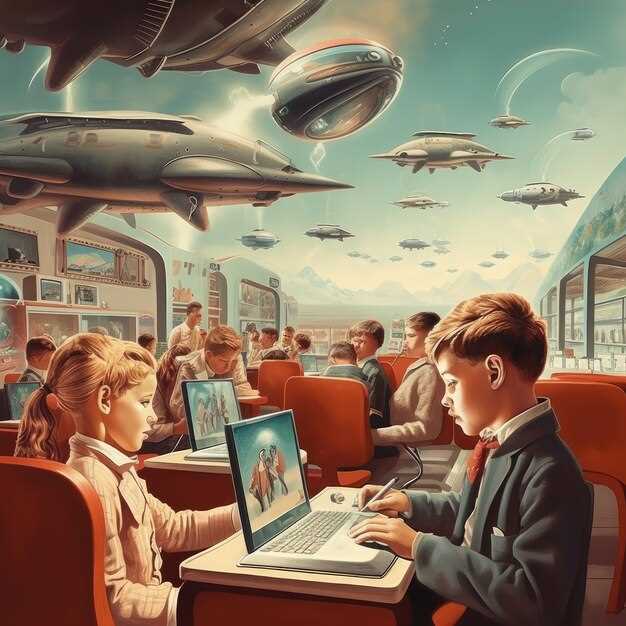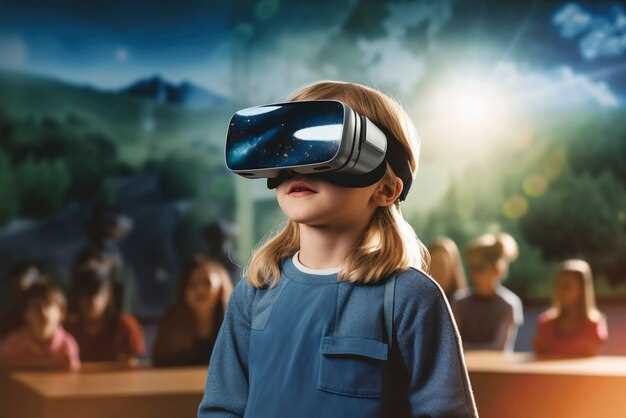Immersive technologies are heralding a new age in personal growth and knowledge acquisition. Imagine a world where barriers between classrooms and real-life scenarios blur effortlessly. This shift could open doors to limitless possibilities. Engaging with subjects in vibrant, interactive environments enriches understanding. Learning becomes more than memorizing facts; it evolves into a dynamic journey of discovery.
As learners step into these interactive realms, they find themselves surrounded by captivating visuals and stimulating challenges. Traditional methods often fall short in capturing attention. However, when students can navigate complex concepts through virtual simulations, comprehension flourishes. Each participant is not merely an observer but an active player within a unique narrative.
Such an evolution demands a rethinking of pedagogical approaches. Collaboration and creativity take center stage. Through shared experiences, individuals cultivate critical thinking skills and emotional intelligence. This innovative foundation helps them prosper in an ever-evolving landscape. Seeking knowledge becomes an adventure rather than a chore.
Ultimately, with the integration of these pioneering tools, society stands at the threshold of a revolution. Visionaries in various fields recognize the immense potential present in this shift. Envisioning a future where learners thrive in engaging communities, they inspire continuous evolution. Preparing individuals for challenges ahead requires an adaptable, engaging strategy that resonates with diverse talents. What lies ahead is a harmonious blend of technology and inquisitiveness, redefining our approach to knowledge.
The Metaverse and Education: Transforming Learning Experiences

In recent times, immersive digital realms have garnered significant attention, reshaping how individuals acquire knowledge. These innovative spaces offer a unique opportunity for interaction, engagement, and exploration. Instead of traditional classrooms, virtual environments create dynamic platforms for information exchange. Students can connect with one another in unprecedented ways.
Such advanced settings foster creativity and collaboration among diverse learners. Through realistic simulations, participants immerse themselves in various scenarios, enhancing understanding. Therefore, educational journeys take on new dimensions, breaking down geographical boundaries.
By integrating cutting-edge technology, educators can craft tailor-made curricula that resonate with individual needs. As learners engage with interactive content, retention rates soar, making the process enjoyable and effective. Shared experiences in these immersive landscapes allow individuals to develop essential skills while enjoying the excitement of discovery.
These interactive platforms not only enhance knowledge absorption but also cultivate teamwork and communication abilities. In this environment, students practice critical thinking as they navigate real-world challenges via simulations, fostering a spirit of innovation. Consequently, the potential for growth is immense, creating a future where education knows no limits.
Innovative Approaches to Learning in Virtual Worlds

New methods enhance engagement in immersive environments. Students can delve deeper into subjects. Traditional teaching frameworks shift dramatically. It’s all about interaction and exploration.
Virtual landscapes present unique outlets for skill acquisition. Hands-on experiences become accessible from anywhere. Collaboration takes on a different dimension in these three-dimensional settings. Learners no longer sit passively in classrooms; they actively navigate their surroundings and participate in dynamic scenarios that challenge their perspectives.
One innovative approach is the use of gamification. Gamified elements in lessons foster motivation and persistence. Students tackle challenges while working toward common goals. They get instant feedback on their performance, leading to continuous improvement. This form of engagement is unlike anything found in typical educational settings.
| Approach | Description |
|---|---|
| Gamification | Injecting game-like elements into education to boost motivation. |
| Simulation-based Learning | Replicating real-world scenarios for practical skill development. |
| Collaborative Projects | Encouraging teamwork in virtual communities enhances problem-solving. |
Simulation-based techniques also play a crucial role in this evolution. Students can participate in realistic scenarios, fostering critical thinking. Such environments allow them to analyze outcomes safely and creatively. They gain confidence by experimenting with various solutions without fearing failure.
Finally, collaborative projects in virtual spaces create vibrant communities. Different backgrounds enrich discussions and ideas flourish. Learners share insights, challenging one another’s viewpoints and promoting deeper understanding. By building connections, they cultivate skills essential for thriving in an interconnected world.
Creating Engaging Educational Environments
Engaging settings play a crucial role in fostering motivation and curiosity. They ignite a spark in learners’ minds. Such environments can significantly enhance participation. When individuals feel connected, they thrive. This connection cultivates collaboration and creativity, essential elements of a vibrant learning atmosphere.
Modern tools can revolutionize these spaces in unprecedented ways. By integrating interactive elements, instructors can draw learners into rich, immersive contexts. Virtual simulations or realistic scenarios allow participants to apply knowledge practically. Gamification methods turn mundane topics into exciting challenges. This approach transforms perceptions of difficulty into opportunities for growth.
Flexibility becomes vital when designing captivating settings, as various learning styles coexist. Personalization is key to addressing unique needs. Instructors should strive to create an inclusive atmosphere where all voices matter. A balance between freedom and guidance can empower learners to take ownership of their journey.
Integrating technology serves as a powerful catalyst for engagement. Tools such as augmented reality can bring abstract concepts to life. With accessible resources, facilitators can encourage exploration beyond traditional boundaries. Even mundane lessons can transform into memorable events, leaving lasting impressions on participants.
Creating an inviting, dynamic environment requires innovative thinking and adaptation. Encouraging collaboration among peers fosters deeper understanding through dialogue. Whether through group projects or shared experiences, connection deepens learning. Ultimately, the aim is to develop a sense of community where individuals feel supported and inspired.
Role of Avatars and Personalization
Avatars serve as digital representatives, allowing users to express their identities. They offer a unique way to engage in virtual settings. Personalization enhances this interaction, making experiences more relevant and impactful. With avatars, learners can tailor their personas, choosing appearance and attributes that resonate with them. This connection fosters a sense of belonging.
When individuals feel represented, their motivation flourishes. Educators can leverage these digital personas to create immersive environments. By customizing avatars, participants not only feel more at ease but also more invested in activities. Personalization touches every aspect–from outfit choices to learning styles tailored through avatar interactions. This blend of identity and personalization results in more meaningful engagement.
As users navigate through various scenarios, their avatars react, learn, and grow with them. Immersive features allow for the adaptation of content based on how learners engage with their environment. Just imagine an educational landscape where each choice made by an avatar delivers insights specific to that learner’s journey. This dynamic creates a feedback loop that keeps participants actively involved in the process.
Moreover, incorporating diverse avatars promotes inclusivity, acknowledging various backgrounds and cultures. Users can explore different perspectives through avatar interactions. This fosters empathy, understanding, and collaboration among participants. The customization potential taps into individual preferences, ensuring everyone finds their niche in virtual realms. It’s a new frontier in connection and understanding.
Strategies for Interactive Curriculum Design
Creating engaging curricula requires innovation and flexibility. Educators must embrace new technologies. Traditional methods often fall short in stimulating student interest. Interactive design offers fresh pathways, fostering active participation.
Incorporating immersive elements can significantly improve retention rates. When students feel involved, they learn more effectively. Thus, it is crucial to employ various strategies to enhance collaboration and creativity.
- Integrate gamification techniques to motivate learners.
- Utilize virtual reality environments for deep immersion.
- Encourage peer collaboration through group projects.
- Design real-world problem-solving tasks to develop critical thinking.
In addition, storytelling can serve as a powerful tool, engaging students emotionally while facilitating understanding of complex concepts. By weaving narratives into lessons, educators foster a stronger connection between subject matter and learner experience.
- Analyze student feedback to refine interactive elements continuously.
- Incorporate multimedia resources that cater to diverse learning styles.
- Structure assessments to allow for creative expression.
Ultimately, reimagining curricula within an interactive framework leads not only to better outcomes but also to empowered individuals ready to tackle future challenges. Connecting educational content with real-world applications cultivates a meaningful learning atmosphere.
Bridging Distance with Virtual Classrooms
Modern technology reshapes how individuals connect and collaborate across vast spaces. Distance no longer inhibits learning; instead, it creates opportunities for collective intellectual growth. Virtual classrooms empower students to engage meaningfully, share insights, and expand their understanding of the world. No matter where one is located, access to quality instruction can flourish.
This environment fosters inclusivity and diversity. Students from various backgrounds come together, enriching discussions. The digital platform facilitates interaction in ways traditional settings may not. Collaborative projects become more feasible, sparking creativity and innovation, while tailored resources ensure that everyone’s unique needs are met.
Time zones hold less significance when knowledge flows unrestricted. A learner in New York can easily participate in a class led by an expert in London, simultaneously contributing unique perspectives. This global exchange of ideas not only broadens horizons but also nurtures empathy, connecting individuals over shared goals and aspirations.
Additionally, advancements in technology enable immersive simulations that can replicate real-life scenarios. This practical approach deepens comprehension, as students can actively apply concepts instead of relying solely on theoretical understanding. Immediate feedback mechanisms further enhance this interactive process, promoting self-improvement and mastery of topics.
In essence, virtual learning environments pave the way for unprecedented dialogues, bridging not just distance but also differences. Through diverse connections, enriched interactions emerge, spawning a dynamic platform for knowledge acquisition and personal growth. As collaboration transcends geographical boundaries, everyone stands to benefit in profound ways, fostering a truly global community.
Enhancing Skills through Immersive Learning

Innovative methods of skill development are emerging rapidly, revolutionizing traditional approaches. Immersive environments provide unique opportunities for engagement. Learners can interact with content in ways previously unimaginable. This fosters deeper understanding and retention of information. The dynamic nature of such platforms captivates attention.
Unlike conventional classrooms, these immersive settings allow for practical application. Learners experience real-world scenarios without leaving their homes. This adaptability makes it easier to grasp complex concepts. Moreover, collaboration becomes more natural through shared digital spaces. Students can work together seamlessly, sharing insights in real time.
Furthermore, the integration of gamification elements adds a layer of motivation that traditional methods often lack. Progression through challenges boosts learners’ self-efficacy and commitment. The excitement generated enhances long-term retention of knowledge. Consequently, individuals are better prepared for professional environments where skills are essential. As they navigate through engaging tasks, learners not only absorb information but also practice problem-solving and critical thinking.
Finally, as technology continues to advance, these immersive learning experiences will increasingly reflect the needs of various industries. Tailored simulations for different fields can equip individuals with the competencies demanded by employers. Continuous feedback loops will assist in tracking progress, allowing for personalized adjustments to enhance outcomes. Ultimately, the journey toward mastery transforms into an engaging adventure, paving the way for tomorrow’s visionary thinkers.
Real-World Applications of Virtual Technologies
Virtual technologies are reshaping numerous fields, moving beyond just entertainment. Their impact is evident in various sectors, enhancing efficiency and engagement. From healthcare to architecture, the potential applications seem limitless. Innovations bring new dimensions to traditional practices, allowing for immersive interactions.
In healthcare, for instance, simulations enable training for medical professionals without real-life risks. Surgeons can practice complex procedures in a controlled virtual space. This not only boosts their skills but ensures better patient outcomes. Moreover, telemedicine has gained traction, providing remote consultations and reducing travel burdens.
- Real estate can harness virtual tours to showcase properties.
- Construction utilizes 3D modeling for effective project planning.
- Retail offers virtual fitting rooms, improving customer experience.
- Entertainment industries host virtual concerts, reaching global audiences.
Beyond just these industries, educational institutions also leverage virtual environments to provide unique insights into complex subjects, making abstract concepts tangible. Students can explore historical sites or conduct science experiments in realistic simulations, thus deepening their understanding and fostering a sense of curiosity.
Corporate training sessions now often integrate virtual reality experiences to simulate real-life scenarios, enhancing employee skills while promoting team collaboration. Participants can engage in role-playing exercises that mimic actual workplace challenges, allowing for practical solutions in a safe yet dynamic environment.
Overall, applications of these virtual technologies pave the way for innovative solutions that cater to diverse needs. Whether enhancing skills, motivating learners, or revolutionizing service delivery, their role grows increasingly vital. As these tools evolve, their integration into daily life becomes inevitable, marking a significant shift in societal operations.
Gamification and Student Motivation
Engaging learners through playful elements can revolutionize how they interact with academic content. When game-like features are introduced, they often result in heightened enthusiasm among students. This approach taps into intrinsic desires for achievement, competition, and collaboration. In essence, it creates an environment that invites participation. Traditional methods may lack this dynamic element, leaving many students disengaged.
Incorporating gamified components encourages students to strive for mastery, unlocking their potential. As they navigate various challenges, they receive immediate feedback that fosters a sense of accomplishment. Through quests, badges, or leaderboards, learners can track their progress in tangible ways. Gamification often helps bridge the gap between effort and reward, driving motivation.
This method not only enhances retention of knowledge but also cultivates critical thinking skills. As students immerse themselves in these captivating scenarios, they develop a deeper understanding of subject matter. Engaging in problem-solving tasks allows them to apply theoretical concepts practically. Thus, an interactive atmosphere is established, transforming mundane tasks into exciting adventures.
Furthermore, social dynamics play a significant role in this approach. Collaboration among peers can ignite a sense of community. Sharing successes, competing respectfully, and working together on challenges fosters strong relationships. These connections ultimately enhance the overall learning journey, encouraging continuous growth.
In summary, introducing game principles offers an innovative pathway to enhance student involvement. By creating an inviting and stimulating environment, students are likely to thrive. This shift not only invigorates traditional paradigms but also inspires a future with limitless possibilities for academic engagement.
Collaborative Learning in Digital Spaces
Collaboration in virtual environments offers exciting possibilities. It fosters interaction among learners from diverse backgrounds. In this context, individuals can share knowledge freely. Creativity thrives, and innovative ideas emerge in real-time. This dynamic atmosphere enhances engagement levels significantly.
When participants work together, they build a sense of community. Physical distance becomes irrelevant in shared digital spaces. Different perspectives enrich discussions, leading to deeper understanding. Tools for communication have advanced, allowing seamless exchanges. Video calls, chats, and collaborative documents facilitate synergy.
In such settings, teamwork skills are honed naturally. As participants navigate tasks, they learn to rely on one another. This interconnectedness promotes accountability and shared responsibility for results. Providing constructive feedback takes center stage, inspiring growth and improvement.
Moreover, real-world problem-solving becomes a collective venture. Participants tackle projects that require critical thinking and creativity. They learn not just from materials, but also from each other. This enriches the process, creating a vibrant tapestry of shared insights.
Ultimately, collective efforts pave the way for holistic development. Empowered by technology, individuals can reach new heights of understanding. Collaborative engagements create a fertile ground for lifelong learning. Skills gained in this realm transcend boundaries, preparing students for diverse career paths.
Video:
VR and AI in Education: The Future of Learning | Kristen Tamm | TEDxTartuED
VR and AI in Education: The Future of Learning | Kristen Tamm | TEDxTartuED by TEDx Talks 20,695 views 1 year ago 12 minutes, 37 seconds
Q&A:
What is the Metaverse, and how does it relate to education?
The Metaverse is a collective virtual shared space that merges physical and digital realities, often facilitated by augmented reality (AR) and virtual reality (VR) technologies. In the context of education, the Metaverse creates immersive environments where learners can engage with content interactively. This allows for a more dynamic learning experience compared to traditional methods, as students can collaborate globally, explore simulations, and participate in experiential learning activities that enhance understanding and retention of information.
What are some potential benefits of using the Metaverse in educational settings?
Using the Metaverse in education offers several potential benefits, including increased engagement through immersive experiences, personalized learning paths that can be tailored to individual needs, and improved accessibility for students who may face barriers in traditional educational settings. Additionally, the Metaverse enables collaborative learning where students can work together in virtual environments, fostering teamwork and communication skills. It also allows for real-time feedback and assessments in a simulated context, offering students the chance to learn from mistakes in a safe space.
Are there any challenges associated with implementing Metaverse technologies in education?
Yes, there are several challenges to consider when implementing Metaverse technologies in education. These include the need for significant investment in hardware and software, as well as ongoing maintenance costs. There may also be a steep learning curve for educators who are not familiar with these technologies, which can hinder effective integration. Additionally, issues of digital equity need to be addressed, as not all students may have access to the necessary devices or high-speed internet connections required for immersive learning experiences. Finally, concerns regarding data privacy and security are paramount, as the collection of user data in virtual environments must be managed carefully to protect students’ information.
How can educators prepare for a transition to the Metaverse for learning?
Educators can take several steps to prepare for a transition to the Metaverse. First, professional development opportunities should be pursued to enhance their understanding of AR and VR technologies, as well as best practices for integrating these tools into their teaching. Collaborating with technology specialists and curriculum developers can also help in designing effective Metaverse learning experiences. Moreover, educators should aim to create inclusive curricula that accommodate diverse learning styles and needs. Piloting smaller-scale projects before a full transition can provide valuable insights and help refine approaches. Lastly, establishing clear objectives and evaluating the effectiveness of Metaverse initiatives will be crucial for ongoing improvement and adaptation in the educational landscape.
